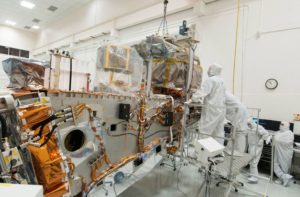
Later this year, an ambitious new Earth-monitoring satellite will launch into a polar orbit
around our planet. The new satellite—called JPSS-1—is a collaboration between NASA
and NOAA. It is part of a mission called the Joint Polar Satellite System, or JPSS.
At a destination altitude of only 824 km, it will complete an orbit around Earth in just 101
minutes, collecting extraordinarily high-resolution imagery of our surface, oceans and
atmosphere. It will obtain full-planet coverage every 12 hours using five separate,
independent instruments. This approach enables near-continuous monitoring of a huge
variety of weather and climate phenomena.
JPSS-1 will improve the prediction of severe weather events and will help advance early
warning systems. It will also be indispensable for long-term climate monitoring, as it will
track global rainfall, drought conditions and ocean properties.
The five independent instruments on board are the main assets of this mission:
• The Cross-track Infrared Sounder (CrIS) will detail the atmosphere’s 3D
structure, measuring water vapor and temperature in over 1,000 infrared spectral
channels. It will enable accurate weather forecasting up to seven days in advance
of any major weather events.
• The Advanced Technology Microwave Sounder (ATMS) adds 22 microwave
channels to CrIS’s measurements, improving temperature and moisture readings.
• Taking visible and infrared images of Earth’s surface at 750 meter resolution, the
Visible Infrared Imaging Radiometer Suite (VIIRS) instrument will enable
monitoring of weather patterns, fires, sea temperatures, light pollution, and ocean
color observations at unprecedented resolutions.
• The Ozone Mapping and Profiler Suite (OMPS) will measure how ozone
concentration varies with altitude and in time over every location on Earth’s
surface. This can help us understand how UV light penetrates the various layers of
Earth’s atmosphere.
• The Clouds and the Earth’s Radiant System (CERES) instrument will quantify the
effect of clouds on Earth’s energy balance, measuring solar reflectance and
Earth’s radiance. It will greatly reduce one of the largest sources of uncertainty in
climate modeling.
The information from this satellite will be important for emergency responders, airline
pilots, cargo ships, farmers and coastal residents, and many others. Long and short term
weather monitoring will be greatly enhanced by JPSS-1 and the rest of the upcoming
satellites in the JPSS system.
Want to teach kids about polar and geostationary orbits? Go to the NASA Space Place: geostationary orbits


